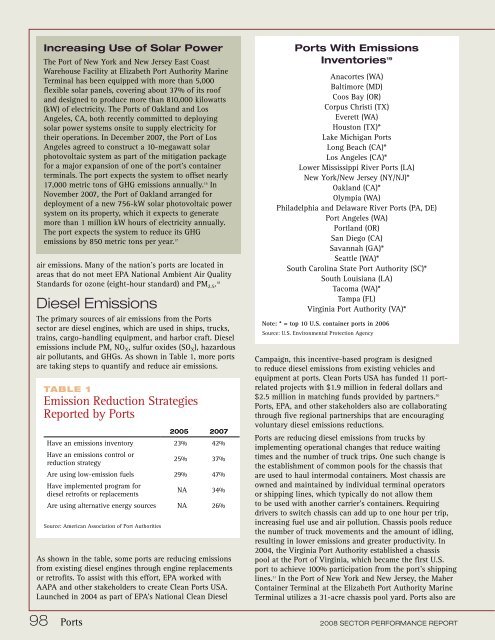2008 Sector Performance Report - US Environmental Protection ...
2008 Sector Performance Report - US Environmental Protection ...
2008 Sector Performance Report - US Environmental Protection ...
You also want an ePaper? Increase the reach of your titles
YUMPU automatically turns print PDFs into web optimized ePapers that Google loves.
Increasing Use of Solar Power<br />
The Port of New York and New Jersey East Coast<br />
Warehouse Facility at Elizabeth Port Authority Marine<br />
Terminal has been equipped with more than 5,000<br />
flexible solar panels, covering about 37% of its roof<br />
and designed to produce more than 810,000 kilowatts<br />
(kW) of electricity. The Ports of Oakland and Los<br />
Angeles, CA, both recently committed to deploying<br />
solar power systems onsite to supply electricity for<br />
their operations. In December 2007, the Port of Los<br />
Angeles agreed to construct a 10-megawatt solar<br />
photovoltaic system as part of the mitigation package<br />
for a major expansion of one of the port’s container<br />
terminals. The port expects the system to offset nearly<br />
17,000 metric tons of GHG emissions annually. 16 In<br />
November 2007, the Port of Oakland arranged for<br />
deployment of a new 756-kW solar photovoltaic power<br />
system on its property, which it expects to generate<br />
more than 1 million kW hours of electricity annually.<br />
The port expects the system to reduce its GHG<br />
emissions by 850 metric tons per year. 17<br />
air emissions. Many of the nation’s ports are located in<br />
areas that do not meet EPA National Ambient Air Quality<br />
Standards for ozone (eight-hour standard) and PM 2.5 . 18<br />
Diesel Emissions<br />
The primary sources of air emissions from the Ports<br />
sector are diesel engines, which are used in ships, trucks,<br />
trains, cargo-handling equipment, and harbor craft. Diesel<br />
emissions include PM, NO X , sulfur oxides (SO X ), hazardous<br />
air pollutants, and GHGs. As shown in Table 1, more ports<br />
are taking steps to quantify and reduce air emissions.<br />
Table 1<br />
Emission Reduction Strategies<br />
<strong>Report</strong>ed by Ports<br />
2005 2007<br />
Have an emissions inventory 23% 42%<br />
Have an emissions control or<br />
reduction strategy<br />
25% 37%<br />
Are using low-emission fuels 29% 47%<br />
Have implemented program for<br />
diesel retrofits or replacements<br />
NA 34%<br />
Are using alternative energy sources NA 26%<br />
Source: American Association of Port Authorities<br />
As shown in the table, some ports are reducing emissions<br />
from existing diesel engines through engine replacements<br />
or retrofits. To assist with this effort, EPA worked with<br />
AAPA and other stakeholders to create Clean Ports <strong>US</strong>A.<br />
Launched in 2004 as part of EPA’s National Clean Diesel<br />
Ports With Emissions<br />
Inventories 19<br />
Anacortes (WA)<br />
Baltimore (MD)<br />
Coos Bay (OR)<br />
Corpus Christi (TX)<br />
Everett (WA)<br />
Houston (TX)*<br />
Lake Michigan Ports<br />
Long Beach (CA)*<br />
Los Angeles (CA)*<br />
Lower Mississippi River Ports (LA)<br />
New York/New Jersey (NY/NJ)*<br />
Oakland (CA)*<br />
Olympia (WA)<br />
Philadelphia and Delaware River Ports (PA, DE)<br />
Port Angeles (WA)<br />
Portland (OR)<br />
San Diego (CA)<br />
Savannah (GA)*<br />
Seattle (WA)*<br />
South Carolina State Port Authority (SC)*<br />
South Louisiana (LA)<br />
Tacoma (WA)*<br />
Tampa (FL)<br />
Virginia Port Authority (VA)*<br />
Note: * = top 10 U.S. container ports in 2006<br />
Source: U.S. <strong>Environmental</strong> <strong>Protection</strong> Agency<br />
Campaign, this incentive-based program is designed<br />
to reduce diesel emissions from existing vehicles and<br />
equipment at ports. Clean Ports <strong>US</strong>A has funded 11 portrelated<br />
projects with $1.9 million in federal dollars and<br />
$2.5 million in matching funds provided by partners. 20<br />
Ports, EPA, and other stakeholders also are collaborating<br />
through five regional partnerships that are encouraging<br />
voluntary diesel emissions reductions.<br />
Ports are reducing diesel emissions from trucks by<br />
implementing operational changes that reduce waiting<br />
times and the number of truck trips. One such change is<br />
the establishment of common pools for the chassis that<br />
are used to haul intermodal containers. Most chassis are<br />
owned and maintained by individual terminal operators<br />
or shipping lines, which typically do not allow them<br />
to be used with another carrier’s containers. Requiring<br />
drivers to switch chassis can add up to one hour per trip,<br />
increasing fuel use and air pollution. Chassis pools reduce<br />
the number of truck movements and the amount of idling,<br />
resulting in lower emissions and greater productivity. In<br />
2004, the Virginia Port Authority established a chassis<br />
pool at the Port of Virginia, which became the first U.S.<br />
port to achieve 100% participation from the port’s shipping<br />
lines. 21 In the Port of New York and New Jersey, the Maher<br />
Container Terminal at the Elizabeth Port Authority Marine<br />
Terminal utilizes a 31-acre chassis pool yard. Ports also are<br />
98 Ports <strong>2008</strong> SECTOR PERFORMANCE REPORT















